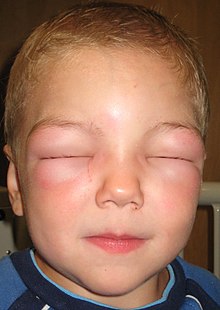User:Mr. Ibrahem/Anaphylaxis
| Anaphylaxis | |
|---|---|
| Other names | Anaphylactoid, anaphylactic shock |
 | |
| Angioedema of the face such that the boy cannot open his eyes. This reaction was caused by an allergen exposure. | |
| Specialty | Allergy and immunology |
| Symptoms | Itchy rash, throat swelling, shortness of breath, lightheadedness,[1] |
| Usual onset | Over minutes to hours[1] |
| Causes | Insect bites, foods, medications[1] |
| Diagnostic method | Based on symptoms[2] |
| Differential diagnosis | Allergic reaction, angioedema, asthma exacerbation, carcinoid syndrome[2] |
| Treatment | Epinephrine, intravenous fluids[1] |
| Frequency | 0.05–2%[3] |
Anaphylaxis is a serious allergic reaction that is rapid in onset and may cause death.[4][5] It typically causes more than one of the following: an itchy rash, throat or tongue swelling, shortness of breath, vomiting, lightheadedness, and low blood pressure.[1] These symptoms typically come on over minutes to hours.[1]
Common causes include insect bites and stings, foods, and medications.[1] Other causes include latex exposure and exercise.[1] Additionally, cases may occur without an obvious reason.[1] The mechanism involves the release of mediators from certain types of white blood cells triggered by either immunologic or non-immunologic mechanisms.[6] Diagnosis is based on the presenting symptoms and signs after exposure to a potential allergen.[1]
The primary treatment of anaphylaxis is epinephrine injection into a muscle, intravenous fluids, and positioning the person flat.[1][7] Additional doses of epinephrine may be required.[1] Other measures, such as antihistamines and steroids, are complementary.[1] Carrying an epinephrine autoinjector and identification regarding the condition is recommended in people with a history of anaphylaxis.[1]
Worldwide, 0.05–2% of the population is estimated to experience anaphylaxis at some point in life.[3] Rates appear to be increasing.[3] It occurs most often in young people and females.[7][8] Of people who go to a hospital with anaphylaxis in the United States about 99.7% survive.[9] The term comes from the Ancient Greek: ἀνά, romanized: ana, lit. 'against', and the Ancient Greek: φύλαξις, romanized: phylaxis, lit. 'protection'.[10]
References[edit]
- ^ a b c d e f g h i j k l m n "Anaphylaxis". National Institute of Allergy and Infectious Diseases. April 23, 2015. Archived from the original on 4 May 2015. Retrieved 4 February 2016.
- ^ a b Caterino, Jeffrey M.; Kahan, Scott (2003). In a Page: Emergency medicine. Lippincott Williams & Wilkins. p. 132. ISBN 9781405103572. Archived from the original on 2017-09-08.
- ^ a b c Simons, FE; Ardusso, LR; Bilò, MB; El-Gamal, YM; Ledford, DK; Ring, J; Sanchez-Borges, M; Senna, GE; Sheikh, A; Thong, BY; World Allergy, Organization. (February 2011). "World allergy organization guidelines for the assessment and management of anaphylaxis". The World Allergy Organization Journal. 4 (2): 13–37. doi:10.1097/wox.0b013e318211496c. PMC 3500036. PMID 23268454.
- ^ Sampson HA, Muñoz-Furlong A, Campbell RL, et al. (February 2006). "Second symposium on the definition and management of anaphylaxis: summary report—Second National Institute of Allergy and Infectious Disease/Food Allergy and Anaphylaxis Network symposium". The Journal of Allergy and Clinical Immunology. 117 (2): 391–7. doi:10.1016/j.jaci.2005.12.1303. PMID 16461139.
- ^ Tintinalli, Judith E. (2010). Emergency Medicine: A Comprehensive Study Guide (Emergency Medicine (Tintinalli)). New York: McGraw-Hill Companies. pp. 177–182. ISBN 978-0-07-148480-0.
- ^ Khan, BQ; Kemp, SF (August 2011). "Pathophysiology of anaphylaxis". Current Opinion in Allergy and Clinical Immunology. 11 (4): 319–25. doi:10.1097/ACI.0b013e3283481ab6. PMID 21659865.
- ^ a b The EAACI Food Allergy and Anaphylaxis Guidelines Group (August 2014). "Anaphylaxis: guidelines from the European Academy of Allergy and Clinical Immunology". Allergy. 69 (8): 1026–45. doi:10.1111/all.12437. PMID 24909803.
- ^ Lee, JK; Vadas, P (July 2011). "Anaphylaxis: mechanisms and management". Clinical and Experimental Allergy. 41 (7): 923–38. doi:10.1111/j.1365-2222.2011.03779.x. PMID 21668816.
- ^ Ma, L; Danoff, TM; Borish, L (April 2014). "Case fatality and population mortality associated with anaphylaxis in the United States". The Journal of Allergy and Clinical Immunology. 133 (4): 1075–83. doi:10.1016/j.jaci.2013.10.029. PMC 3972293. PMID 24332862.
- ^ Gylys, Barbara (2012). Medical Terminology Systems: A Body Systems Approach. F.A. Davis. p. 269. ISBN 9780803639133. Archived from the original on 2016-02-05.
